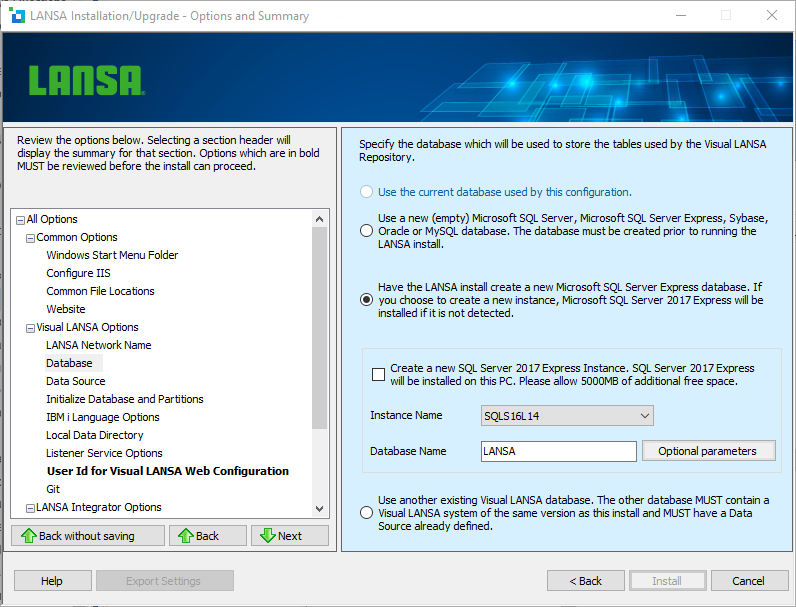
Specify the options that help to determine the type of physical database that is to be used.

Select one of the following options:
Use the current database used by this configuration
This option is not used for a new Install. It is the most likely option when doing an Upgrade or a Modify/Repair.
OR
Use a new Microsoft SQL Server, Sybase, Oracle or MySQL database
LANSA supports the use of these three database products. LANSA will create the database objects it requires (tables, indexes, and so on) but it will not create and configure the database. If you select this option, the database must be created and configured prior to the Visual LANSA install running.
Microsoft SQL Server refers to the full-featured product. It should not be confused with the Microsoft SQL Server Express database described below.
Note 1: Unicode databases are not supported, you must create an SBCS or DBCS database. Unicode columns in database tables are fully supported in SBCS and DBCS databases.
Note 2: Sybase Adaptive Server Anywhere Database:
You will need to ensure that the database has the precision set to 127 and the scale to 63.
You must enable Ignore trailing blanks in string comparisons in Additional Settings for the Adaptive Server Anywhere database.
Note 3. MySQL Database:
By default, MySQL max index key length for a single column is 767 bytes and max row size is 65535.
The key length can be increased by setting these system variables:
'innodb_file_format'=Barracuda
'innodb_file_format_max'=Barracuda
'innodb_large_prefix'=ON
'sql_mode'=<existing values>,PAD_CHAR_TO_FULL_LENGTH (note comma as the delimiter)
Ensure the storage-engine is set to InnoDB and character set is SBCS, latin1. BLOB/CLOB columns are not included. Please refer to the MySQL online documentation for details.
Note 4. Oracle Database:
This database must be OFA compliant. Supported Oracle versions are also included in the list of supported databases, for the Visual LANSA version you are installing, in the Supported Platforms document on the LANSA web site.
OR
Create a new Microsoft SQL Server Express Instance
Microsoft SQL Server 2017 Express is included on the Visual LANSA installation media. Microsoft SQL Server Express is a free version of Microsoft SQL Server. Refer to Microsoft documentation for the differences between Microsoft SQL Server and Microsoft SQL Server Express.
If you select this option, the new database can be created in an existing instance or a new instance. If no SQL Server Express instances exist on the workstation, this option will be selected by default and made read-only so that SQL Server Express is installed and an instance created. An instance must exist for a database to be created. If one or more instances already exist then you may choose to use one of these existing instances or have the Visual LANSA install create a new one.
To change the disk location of the instance or to change the password for the default administrator user, press the Database Instance Optional Parameters button next to the instance name.
To change the disk location of where the database will be created, press the Database Optional Parameters button next to the Database Name.
Note 3: When the Visual LANSA install creates a new Microsoft SQL Server Express instance, it will configure it to use 250mb maximum memory. You can modify the memory usage using SQL Server Management Studio. See Microsoft SQL documentation for details.
Note 4: If you elect to use the Visual LANSA installation to create a Microsoft SQL Server or Microsoft SQL Server Express database, LANSA will use the TCP/IP connection to communicate with the database that is created. If you turn your firewall software on after the Visual LANSA installation is completed, you will need to put sqlbrowser.exe and ports 1434, 1433 into exception.
Note 5: Checks will be made to ensure that any software currently installed will not conflict with Microsoft SQL. Prerequisites will be automatically installed. Refer to Microsoft's documentation and/or website for a list of prerequisites and conflicts.
OR
Use an existing database
This indicates that the target database already exists and contains an existing LANSA system. The LANSA system must be same version as the LANSA version being installed. This option should only be used if moving the LANSA configuration associated with the database to a different location on your hard drive or moving to a different PC. This option should not be used to create a scenario where multiple local LANSA configurations (configurations on this PC) connect to the same database. LANSA strongly recommends that each configuration has its own database unless it is being setup as a Network or Local Client or 3.3.5 Client to an Independent Database Server.